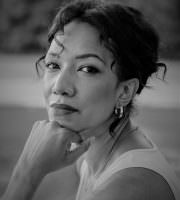by Tiana Clark
Yesterday I was smashed with the rush of fresh honeysuckle
from the greenway near my house where I walk every day.
I’ve been trying to write a poem about buried Black bodies
but all I want to write about is Black joy and my pleasure
and Black love and Black lives that don’t end with viral death,
so I’ve stopped consuming the news. I’ve logged off of social
media for a break. Black bodies are buried in the stickiness of history
every day bodies become the next viral death. And yet, each day
I want to write a poem about pleasure. Black pleasure at the root
instead of viral death. What name now? What Black litany? What
Black elegy is repeated on the news? This cycle: Daunte Wright.
I don’t know the details yet, because I can’t handle the details yet,
but I am mourning him still. This stanza broke the rules. So, what?
This stanza will break back inside the form of honeycomb to suck
the lyric into compression, reboot restraint, the grief-joy every day
when I walk around Sylvan Park near a broken track of burned Black bodies
but all I want to write about is Black joy and pleasure pleasure pleasure
please … and Black love and Black lives that don’t end with viral death,
so I’ve stopped consuming the news. I’ve deleted all my social-media
apps, but logged back in later, saw your name repeating as death
media. Fresh honeysuckle at dusk smells like sweet earth, ripe bodies,
warm floral notes. Heady with romance and nectar. It permeates the day
I walk over the bridge where I often see a single blue heron, not social,
standing stone-still stalking Richland Creek fringed with honeysuckle,
which reminds me of any Mary Oliver poem, such pastoral pleasures.
(I’m also still thinking about Claudia Rankine’s blossoming blood
list of Black bodies broken from police brutality inside Citizen
on page 134. The memoriam fades into the sheer forecast of names
we know will come.) I picked the sestina for its obsessive listing
and twisting. I selected the sestina to probe a problem I can name
but can’t answer. The end words are planets orbiting the math.
Pleasure.
Death.
Honeysuckle
Black bodies.
Social / Media.
Every day.
Every day here are some of the plants and trees I’ve collected during
my walks. I take pictures on my phone so an app can tell me what they are:
ginkgo, bristly locust, maiden pink, garden star-of-Bethlehem, wild pansy,
birdeye speedwell, eastern Redbud, Japanese cherry, apricot, peach,
American holly, beefsteak plant, maypop, common blue wood aster.
Calico aster, eastern white pine, southern sugar maple, scarlet morning glory.
Every day I walk past Dutchman’s Curve, the eerie site of the Great Train
Wreck of 1918. Deadliest train wreck in American history which killed 101
people, mostly African Americans, headed to a factory to make weapons
for World War I. They were stuffed in rickety wooden cars in the front due
to segregation. The front being the most dangerous spot on a train about
to crash, while white bodies were in steel Pullman cars in the back, protected.
But at 100 mph the wooden cars with Black bodies telescoped, splintered,
and caught fire immediately upon impact with another train on the blind curve.
The historian David Ewing describes bodies writhing in pain. Bodies without heads
and limbs. Bodies unidentified, maimed: “The African-Americans that were
on this train did not have a chance to survive, given where they were.”
“The cornfield on both sides of the track was trampled by many feet, and littered with fragments, of iron and wood hurled from the demolished cars. The dead lay here and there, grotesquely sprawling where they fell. The dying moaned appeals for aid or, speechless, rolled their heads from side to side and writhed in agony. Everywhere there was blood and suffering and chaos.”
— Tennessean, June 10, 1918
They asked local butchers to come help manage the gore and horror. Still five
unidentified African American women and three unidentified African American
men destroyed beyond recognition. The railroad masonry abutments remain.
I touched them today.
I went on a first date last Thursday. We both leaned into each other’s mouths
like two tipped tulips and just kissed each other at a bar called Answer as if that was
an answer—it wasn’t. But it was instinctual, sudden and all pleasure. We kissed
all the way down Murphy Road, walking back to our cars, constellation of our juicy
hands everywhere. We kissed and groped, and I stopped obsessively thinking
about death for a few moments, maybe even for a whole evening, which was
the length of a tercet, an envoi sustained
with pleasure reaching for Black desire,
reaching for the transcendence of pain, if possible. Is it possible?
Last updated December 17, 2022




